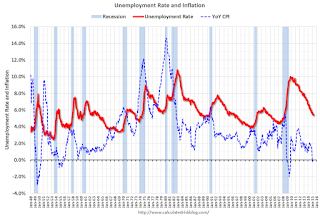by Calculated Risk on 5/11/2015 03:19:00 PM
Monday, May 11, 2015
Demographics, Unemployment Rate and Inflation
It wasn't long ago that several FOMC members were arguing inflation would pick up when the unemployment rate declined to 6%. They were wrong with the unemployment rate now at 5.4%. I think they were looking at the '70s and ignoring the demographic differences.
The first graph shows the year-over-year change in the prime working age population (25 to 54 years old) with projections for the next 25 years.
If there is a demographic component to inflation, then we would have expected inflation to increase in the '70s, and be very low now.
Note: Ignore the steps up and down - the data was affected by changes in population controls.
The dashed red line is based on Census Bureau projections through 2040.

A key is the prime working age population was declining in the early part of this decade and has only started increasing again recently.
This is very similar to what happened in the '60s. In the early '60s, there was a slow increase in the prime working age population until the baby boomers started pouring into the labor force.
Now the prime working age population is growing again, and we can expect growth to pick up over the next decade. However there will not be as large in increase in the prime working age labor force like in the '70s and '80s.

In the 1960s, inflation didn't pickup until the unemployment rate had fallen close to 4% - and when the early baby boomers started entering the labor force.
The current period is similar to the '60s (although there won't be as large a group entering the labor force). And the current period - from a demographics perspective - is very different from the '70s and '80s.
Ignoring for the moment monetary and fiscal policy differences between the '60s and now, demographics suggests that the unemployment rate will have to fall below 5% before inflation picks up.


